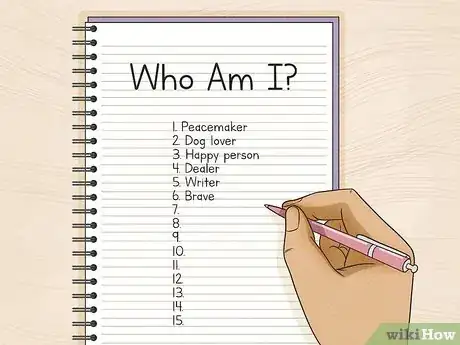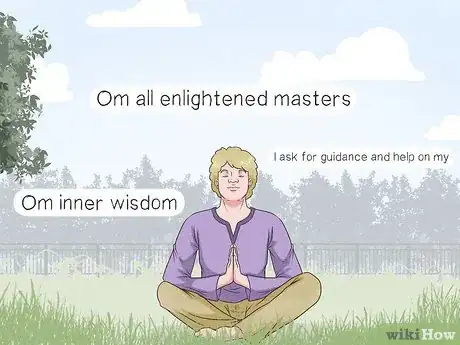This article was co-authored by Soken Graf. Soken Graf is a Meditation Coach, Buddhist Priest, Certified Advanced Rolfer, and a Published Author who runs Bodhi Heart Rolfing and Meditation, a spiritual life coaching business based in New York City, New York. Soken has over 25 years of Buddhist training experience and advises entrepreneurs, business owners, designers, and professionals. He has worked with organizations such as the American Management Association as a consultant for training courses on such topics as Mindful Leadership, Cultivating Awareness, and Understanding Wisdom: The Compassionate Principles of Work-Life Balance. In addition to his work as a priest, Soken has certifications in Advanced Rolfing from the Rolf Institute of Structural Integration, Visceral Manipulation, Craniosacral Therapy, SourcePoint Therapy®, and Cold-Laser Therapy.
There are 7 references cited in this article, which can be found at the bottom of the page.
wikiHow marks an article as reader-approved once it receives enough positive feedback. In this case, 100% of readers who voted found the article helpful, earning it our reader-approved status.
This article has been viewed 265,239 times.
Meditation is a process of letting go. Too often people try to control all the events of their lives. They think, they plan, and they rehearse even the most menial daily tasks. Even when people think talking to themselves is odd, they will have verbal and imagined conversations in their head throughout the day. In meditation, you seek to quiet that inner voice that never ceases to plan, think, remember, and criticize. When you learn to meditate with your inner voice you will let go of your need to control and find peace in relaxation.
Steps
Finding Your Inner Voice
-
1Differentiate yourself from the world's expectations.[1] This can be a difficult task. Who you are is largely a reflection of how you think others see you. Consequently, there is a part of yourself that is a collection of things you've done and other memories of being in different situations. The other part is how you remember or think other people feel about you both now and in the past.
- Try writing a list of who you are.[2] On a piece of paper, number 1 to 20. For each number, give a different answer to the statement "Who am I?". Then look at each statement and decide if that's primarily based on what you think of yourself or what others think of you.
-
2Focus on your initial impressions.[3] In any situation your initial response tends to be sub-cognitive. That's to say it is almost a "gut-feeling" that you have to make sense of. This is your intuition. Your intuition speaks to you with your inner voice to say to move forward or be cautious.
- Sometimes we have both an immediate feeling and counter-feeling. The immediate feeling is your initial impression. The counter-feeling is a cognitive (i.e., thought) response based on ideas such as "What 'should' I think or feel?" or "What would other people do?". That initial impression is your inner voice.
Advertisement -
3Listen to the conversations in your mind.[4] Much of the time, your inner voice is in conflict with external motives. You imagine what society thinks or what your parents, friends, or partner might think. Your inner voice has conversations with these people as if a real discussion takes place.
- This is not to say that your initial impressions are more correct or accurate than the opinions of others. The goal is not to evaluate the information being presented--just to focus on what your own unique contribution is to a situation.
-
4Identify the sources of each voice in the conversation.[5] If you know your inner voice you can identify your own intuition and beliefs. The other opinions that conflict or agree, by default, are then other people or groups. Even if you can't put a name or face to an opinion, knowing that the opinion is not of your inner voice is sufficient.
- If you are a particularly submissive individual you may find it difficult to differentiate your inner voice from that of an oppressive other. You can identify this oppressive other as the one who almost immediately overrides your intuition. You will frequently imagine their facial expressions when you hear their imagined voice.
- Try journalling about your thoughts. Write down the arguments and statements. Then go back and try to put a face to the individual arguments. For example, "Oh, that's what my dad would say."
-
5Quiet the voices that are not your own. When you know what your inner voice sounds like in the crowd, start focusing on it. Ignore all the other voices. This means leave the conversation. As you quiet the other voices you will find your inner voice is the only one left. Now when you listen, you can hear your inner voice loud and clear.
- Do not waste time fighting with conflicting opinions. Just as in real life, the more you stand there and argue, the more occupied you are. Simply leave the conversation to quiet the racket.
- If you have trouble identifying your inner voice from the others, silence all of them. Try to quiet your mind altogether. Then focus only on your impressions or gut-feelings. Listen to the voices and identify which comments are consistent with your impressions and gut-feelings. That's your inner voice.
Communing With Your Inner Voice
-
1Sense your inner voice.[6] Your inner voice begins to speak to you through subtle feelings. You may sense a conflict of sorts in your mind and body. Your inner voice is trying to speak to you but is being drowned out by other voices. When you sense your inner voice trying to speak this is a good time to commune.
- Sometimes you may only know your inner voice is trying to speak to you when you sense an unresolved conflict in your mind. Another method is when you have an answer to a question or decision but it just doesn't settle well with you. That part of you saying "Hold on a minute" is your inner voice.
-
2Close your eyes to concentrate on hearing more clearly.[7] You want to limit the number of distractions you must ignore. Listening to your inner voice is difficult enough with distracting thoughts and imagined opinions. You may want to find a quiet place where you will not be interrupted. Even with your eyes closed people may walk up and demand your attention.
- If closing your eyes does not work, try getting up and walking around. You may choose to pace in you home for serious one-on-one conversations or go for a walk outside if you need a distraction from your current setting.
-
3Focus on your listening to inner voice. If you have practiced differentiating your inner voice from the imagined voices of others this will be easier. As you hear your inner voice, focus on it and what it is saying. When you hear alternate opinions slip into your mind, ignore them as you would a passerby on the sidewalk talking to someone else. They are not invited to this discussion.
-
4Respond to your inner voice when it speaks. When your inner voice speaks, speak back to it. You may want to do this out loud. This focuses your mind on speaking rather than listening to potentially interrupting imagined opinions. Be totally straight forward. Your inner voice not only knows your deepest thoughts--it is your deepest thoughts.
- Responding out-loud to your inner voice makes the conversation seem more realistic and natural. This also helps you to differentiate your inner voice from your own voice.
- When you feel that internal conflict arising you might consider going back to journalling to focus on your inner voice's contributions juxtaposed to the noise of other imagined opinions.
-
5Follow your inner voice to find peace.[8] Generally your inner voice knows your heart better than you do. Ignoring your inner voice can lead to regret when things don't turn out as expected. You may find that your inner voice advises you to be cautious when you want to hope for the best. You may also find your inner voice giving you wise advise when you want to be rash.
- It may not always be the best decision to follow your inner voice in spite of social norms and conventions. You may need to postpone satisfying your inner voice when it advises actions that could get you fired from you job (e.g., yelling at your boss).
Asking a Question
-
1Send light to the world. Visualize the Earth, move a hand and think: "I send light to... May all people be happy. May the world be happy." .
-
2Visualize the cosmos around you, a universe full of stars. Make large circles with your arms and think: "I take things the way they are. I let go of my false desires. I live in the unity of the cosmos. I flow positive with my life." What do you want to accept or release today? Say: "I accept .... I let go ...".
-
3Connect with the light. Rub your palms in front of the heart chakra and think: "Om all enlightened masters (God). Om inner wisdom. I ask for guidance and help on my way."
-
4Ask a question. Think about your life. What are your goals? What is your way of a wise life? Meditate on your question. Listen to the answer inside. What does your inner wisdom say? What answers your inner wisdom? You feel the answer. Let the answer appear in you. Think the answer several times as a mantra.
Quieting Your Inner Voice
-
1Find a quite place to meditate. Quieting your mind will be impossible to a beginner who does not find a quiet place. Until you are better trained, your mind will be drawn to your surroundings. Even soothing music may prompt you to imagine people playing the instruments.
- Smells can also be very distracting. Practicing meditation in the rest room at work may be a bad idea. However, subtle scents from burning candles may produce a calming effect. They can effectively quiet the smell of a room and also bring you pleasant feelings.
-
2Close your eyes to concentrate.[9] A quiet place may still be very distracting. If you are at home or the office, you may find that everywhere you look there is something else to do. Closing your eyes will keep you focused. Focus on clearing your mind of any imaginations when you close your eyes. You are alone in the dark.
- As an alternative, you may want to keep your eyes open. If when you close your eyes your mind creates vivid imaginations of scenery you may not be able to be alone with your inner voice this way. Instead, sit in a room with nothing in front of you but a lit candle. Focus on the candle's flame instead of the back of your eyelids. A fire in a fireplace or wood stove will work as well.
-
3Breath slowly and deliberately.[10] Concentrate on breathing deeply in and then out. If the room is properly quiet, your ears should be able to hear only your body breathing. Be still and try to avoid rocking or fidgeting. Keep a steady and sustainable rhythm.
- If you are having trouble hearing yourself breath, try breathing more quickly through your nose and exhaling more slowly through your mouth. Your mouth should almost be whistling so that you can hear the sound of the steady flow of air moving through your slightly opened lips.
-
4Focus on a listening to your breathing. This is a constant sound on which you can focus. The goal is to control all of your socially relevant senses. You see nothing or a flame. You smell nothing but a candle or a scentless room. You feel nothing but your seat. And you now hear nothing but the wind moving in and out of your body.
-
5Practice quieting your mind regularly until it becomes natural.[11] When you can focus your mind on external stimuli you can learn that your mind does not always have to be working. Your inner voice does not need to be constantly talking. You can relax. Over time, you will gain control over your inner voice to silence it in the moment.
Expert Q&A
-
QuestionHow do I calm my inner voice?
 Soken GrafSoken Graf is a Meditation Coach, Buddhist Priest, Certified Advanced Rolfer, and a Published Author who runs Bodhi Heart Rolfing and Meditation, a spiritual life coaching business based in New York City, New York. Soken has over 25 years of Buddhist training experience and advises entrepreneurs, business owners, designers, and professionals. He has worked with organizations such as the American Management Association as a consultant for training courses on such topics as Mindful Leadership, Cultivating Awareness, and Understanding Wisdom: The Compassionate Principles of Work-Life Balance. In addition to his work as a priest, Soken has certifications in Advanced Rolfing from the Rolf Institute of Structural Integration, Visceral Manipulation, Craniosacral Therapy, SourcePoint Therapy®, and Cold-Laser Therapy.
Soken GrafSoken Graf is a Meditation Coach, Buddhist Priest, Certified Advanced Rolfer, and a Published Author who runs Bodhi Heart Rolfing and Meditation, a spiritual life coaching business based in New York City, New York. Soken has over 25 years of Buddhist training experience and advises entrepreneurs, business owners, designers, and professionals. He has worked with organizations such as the American Management Association as a consultant for training courses on such topics as Mindful Leadership, Cultivating Awareness, and Understanding Wisdom: The Compassionate Principles of Work-Life Balance. In addition to his work as a priest, Soken has certifications in Advanced Rolfing from the Rolf Institute of Structural Integration, Visceral Manipulation, Craniosacral Therapy, SourcePoint Therapy®, and Cold-Laser Therapy.
Certified Meditation Coach If you're having trouble quieting your inner voice enough to meditate, try a meditation practice that substitutes another voice. For instance, Zen starts with counting, so you're putting all of your energy into numbers, and Tibetan Buddhism has very rigorous visualization exercises. There's also the loving kindness meditation, where your inner voice is a mantra: "May all beings be happy, may all beings be well.
If you're having trouble quieting your inner voice enough to meditate, try a meditation practice that substitutes another voice. For instance, Zen starts with counting, so you're putting all of your energy into numbers, and Tibetan Buddhism has very rigorous visualization exercises. There's also the loving kindness meditation, where your inner voice is a mantra: "May all beings be happy, may all beings be well.
Warnings
- If your inner voice is telling you to do things that will obviously cause harm or injury seek counselling immediately. Sometimes your inner voice needs its own wake-up call.⧼thumbs_response⧽
- Meditation should be done in a safe location away from people who may do you harm. When you are trying to block out all external noise you leave yourself vulnerable. Be careful to secure all your valuables if you choose to meditate in public locations.⧼thumbs_response⧽
References
- ↑ Cooley,C,(1902),"Human Nature and the Social Order",ISBN 1-2965676-5-6
- ↑ http://www.asanet.org/introtosociology/Documents/Twenty%20Statement%20Test.htm
- ↑ https://www.psychologytoday.com/blog/happiness-in-world/201005/listening-your-inner-voice
- ↑ Mead,G,(1934),"Mind, Self, and Society",ISBN 0-2265166-7-9
- ↑ Cooley,C,(1902),"Human Nature and the Social Order",ISBN 1-2965676-5-6
- ↑ https://www.psychologytoday.com/blog/happiness-in-world/201005/listening-your-inner-voice
- ↑ https://www.psychologytoday.com/blog/the-power-slow/201209/how-fine-tune-your-inner-voice
- ↑ https://www.psychologytoday.com/blog/the-power-slow/201209/how-fine-tune-your-inner-voice
- ↑ https://www.psychologytoday.com/blog/the-power-slow/201209/how-fine-tune-your-inner-voice
About This Article
To meditate with your inner voice, also known as your intuition or gut feeling, start by quieting all of the other voices in your head. These other voices might be your friends, family members, or coworkers telling you what to do and how to think. Your inner voice is what you think without the influence of other people. Once you've silenced the other voices in your head, close your eyes and try to focus on your inner voice. Listen to what it has to say, and try talking back to it in your head, like you're having a conversation. If you notice the other voices in your head chiming in to argue, just redirect your focus back to your inner voice. As you're meditating, you can ask your inner voice questions, or you can use it to help you make decisions without being influenced by other people's opinions. To learn how to quiet your inner voice through meditation so you can be more present and relaxed, scroll down!































-Step-18-Version-2.webp)



















































